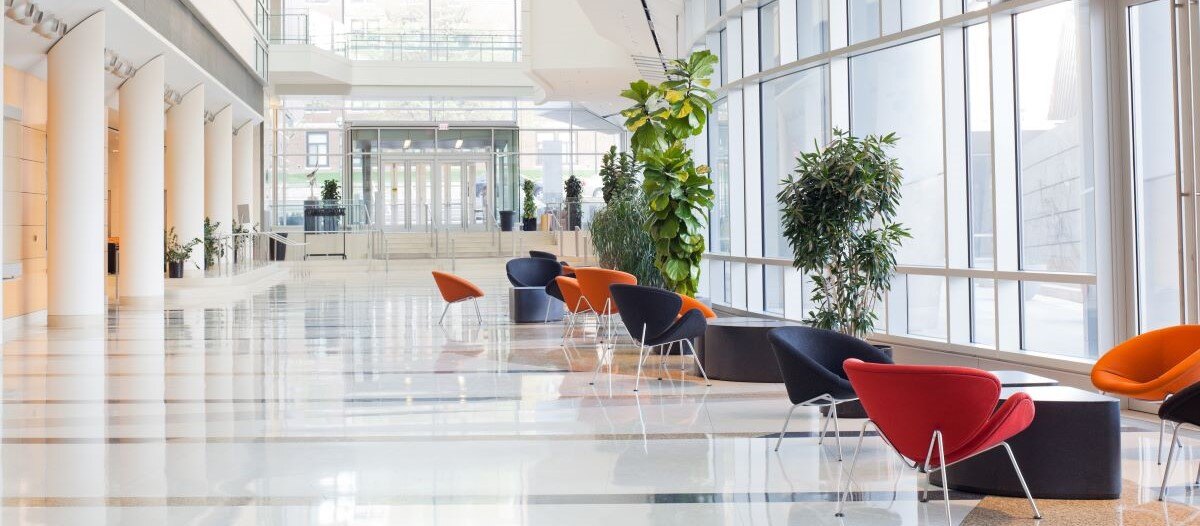Greener & Better
5 O&M technologies changing FM

As people become more concerned with eco-friendly living and working at companies prioritizing sustainability, they also want to visit venues where staff members uphold green building operations and maintenance practices. Here are five examples of technologies that will promote progress in this area.
1. Green Cleaning Products
Green cleaning products encompass a broad category. Generally, manufacturers create them with an emphasis on being safer for people, animals and the planet while reducing resource usage when possible. That might mean they contain bio-based solvents with fewer or no ingredients harming aquatic life. Some green cleaning products have a flash point above 200 degrees Fahrenheit (93 Celsius), making them less flammable. That characteristic spans beyond environmental benefits and makes the whole building safer from potential fires.
In one example, Unilever became the first company to buy a linear alkylbenzene (LAB) made from biomass. LAB is common in commercial cleaning products, including surface cleaners and detergents. However, it is usually made with ingredients derived from fossil fuels. This new LAB is renewable, biodegradable and performs comparably to non-green options.
Other green cleaning products have special formulas that reduce water usage. One floor cleaner from an eco-friendly brand halves the required water usage because people don’t need to rinse after applying it.
Packaging is also important in green cleaning products. Many feature recycled containers or are easy for people to recycle again through curbside programs. Due to the high volumes often used when cleaning commercial buildings, companies frequently offer products in refillable containers. Customers can often save money by purchasing refills, too.
Beyond the cleaning technologies, facility managers should also coach employees to work in ways that do not waste products. That might mean adopting new techniques or becoming more conscious of amounts constituting waste versus appropriate usage.
2. Solar panels
 Solar panels produce less-expensive electricity than fossil fuel-based methods. Plus, panels are increasingly easy to access. Interested persons in the U.S. can also access a 30 percent federal investment tax credit for installing panels on commercial buildings.
Solar panels produce less-expensive electricity than fossil fuel-based methods. Plus, panels are increasingly easy to access. Interested persons in the U.S. can also access a 30 percent federal investment tax credit for installing panels on commercial buildings.
Duke University researchers also discovered another benefit that makes solar panels even more applicable to green building operations and maintenance. They clarified how solar panel adoption leads to less water usage. That is because many fossil fuel energy-based methods — such as fracking or burning and mining coal — require massive amounts of water.
The team calculated that a residential solar installation could save an average of 16,200 gallons of water annually. The researchers confirmed that solar panel manufacturing requires water, too. However, it occurs through a single consumption event and the overall amount needed is much less than fossil-based energy production requires. In contrast, the water consumption associated with fossil fuels happens for as long as someone uses them.
Calculations also revealed states where solar panel installations would be particularly advantageous for reducing water consumption. For example, regions in the northeast U.S. do not use much electricity for air conditioning and usually uses oil-based rather than electric heating. Arizona and California were also great places for solar installations due to their plentiful sunshine and frequent water shortages.
The researchers did not explore the effect on commercial buildings. However, because the impact on residential buildings is so dramatic, it makes sense there would be a bigger one for companies.
3. Solar panel-cleaning robots
People must regularly clean solar panels to keep them operating efficiently. Dirt and other debris can affect how much sunlight the panels absorb. However, the job is even easier thanks to the development of solar panel cleaning robots.
Facility managers are increasingly pursuing sustainable operations and maintenance technologies to make their efforts greener. This can help them save energy and reduce resource usage overall.
A major part of green building operations and maintenance involves scheduling the appropriate service providers to take care of panel upkeep. However, some property managers may want to handle solar panel cleanliness themselves — particularly if a local service provider is unavailable for several weeks or months.
In such cases, people can purchase robots to clean solar panels. One model made by an Israeli company is particularly eco-friendly because bots operate without water. Instead, they use wind-blowing technology and microfiber wipes to remove buildup.
It is also highly likely robots like these will improve. Carnegie Mellon University students are working in Qatar to help machines more efficiently clean dust from panels. They plan to program aerial robots with artificial intelligence to get their desired results. Improvements would be especially meaningful for making solar panel installations more feasible in Qatar, which experiences occasional dust storms.
4. Automated technologies
People in various industries are exploring how automation could help them streamline workflows and overcome numerous challenges. For example, the health care industry has more than 1 million nurses older than 50. It could take a while to train the necessary number of recruits as those professionals gradually retire. Many hospitals use automated technology to accelerate the recordkeeping aspect of the job, thereby reducing the workload during this challenging period.
There are numerous helpful ways to rely on automation regarding green building operations and maintenance. Some might install sensors for lights, water faucets and other resource-intensive components. They only activate when necessary, saving energy and lowering bills. People could also invest in smart thermostats that automatically set the temperature to save money while keeping occupants comfortable.
Some cloud-based services can help FMs digitize their documents and make them searchable. Automation comes into play because these services rely on artificial intelligence to categorize information without human input. The program can analyze photographs, drawings or text to determine how to classify it. These tools allow FMs to run paperless organizations with minimal hassles.
Another way to depend on automation is to use an application that sends automatic notifications about needed maintenance. Staying on top of upkeep supports the environment by reducing the chances of problems that could harm the planet. Poorly maintained equipment is often more likely to leak fluids or have higher emissions rates, which have possible environmental ramifications.
A 2023 survey of FMs showed 43 percent use janitorial maintenance or scheduling software. Similarly, 32% depend on inventory management software. Additionally, 70 percent of those polled prioritize sustainability in their organizations. Not all specialized software has automated features, but it is increasingly common that they do. People accustomed to specialty software should become more open to trying automated capabilities.
5. Internet of Things (IoT) sensors
Some products in the previous category — such as smart thermostats or motion-activated lights — use IoT sensors to work. However, people can also rely on them more broadly, including to get ongoing insights about virtually every part of a building. The results support sustainability by giving FMs more visibility. They can address problems immediately if they notice something amiss. The alternative might mean an issue existing for months before anyone sees it. Such situations frequently waste resources.
Fortunately, people can get real-time information from IoT sensors. One example that combines them with long-range Wi-Fi can significantly reduce energy consumption in commercial buildings. Tests indicated users could expect 15- 20 percent savings after deploying this solution. The system takes data from sensors that monitor temperature, humidity, occupancy and CO2 levels. It detects rapid CO2 level changes in less than 60 seconds. All this data goes to the building’s HVAC system four times per hour, triggering modifications when necessary.
Other tools take data from IoT sensors and use artificial intelligence to make building optimization suggestions oreven indicate specifics, such as the number of people in a structure or whether a specific part of the facility needs cleaning. These tools can collect almost 4 billion data points per month, using them and user feedback to improve how the system works.
Green building O&M makes sense
Today’s customers increasingly want to support businesses that operate sustainably. Keeping eco-friendliness in mind during all stages of FM can help enterprises and organizations become more profitable and competitive.
Besides supporting the bottom line, green building operations and maintenance strategies can help venues, schools and other facilities gain a better reputation and even earn awards or positive press coverage for specific actions. The respective entities are noticed as leaders for peers to admire and follow.
However, people overseeing green changes to an existing strategy must remember that they do not have to alter everything at once. It is usually more practical to choose a technology or two first and give people time to get used to working with them. From there, decision-makers are in an excellent position to scale their green technologies and become familiar with others.
Finally, it is best to get feedback from all involved throughout the process. Tweaking operations to make them more sustainable is an ongoing journey, especially when people use specialized technologies to get the desired outcomes.

References
epa.gov/greenerproducts/identifying-greener-cleaning-products
unilever.com/news/news-search/2022/green-cleaning-powering-the-transition-to-circular-chemistry/
europeancleaningjournal.com/magazine/articles/latest-news/green-cleaning-reducing-water-use
revolutionized.com/commercial-building-solar-panels/
energy.gov/eere/solar/federal-solar-tax-credits-businesses
nocamels.com/2022/10/israeli-robots-to-dry-clean-solar-panels-in-india
qatar.cmu.edu/news/carnegie-mellon-student-researchers-explore-ways-to-improve-solar-panel-efficiency/
smartlinx.com/resources/blog/how-technology-automation-makes-facilities-more-competitive
tech.eu/2022/06/07/oslo-based-findable-unlocks-eur2-million-to-develop-building-documentation-automation-platform/
cmmonline.com/articles/2023-cmm-in-house-facility-management-benchmarking-survey-report
businesswire.com/news/home/20221206005334/en/Semtech%E2%80%99s-LoRa%C2%AE-Devices-Optimize-Building-Management-Systems-in-U.S.
techcrunch.com/2023/04/11/infogrid-raises-90m-for-its-ai-driven-building-monitoring-tech/
Read more on Technology , Real Estate and Sustainability
Explore All FMJ Topics









